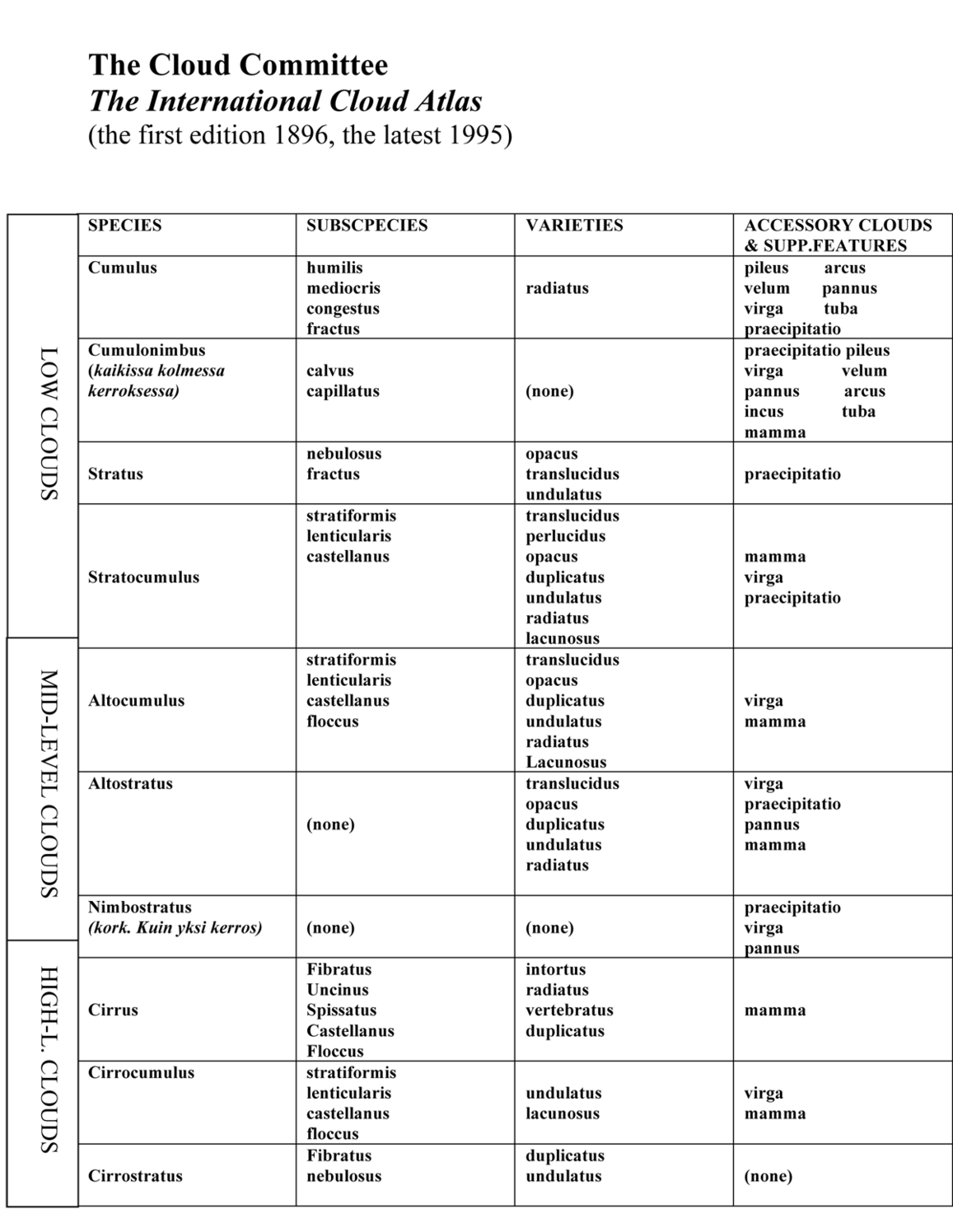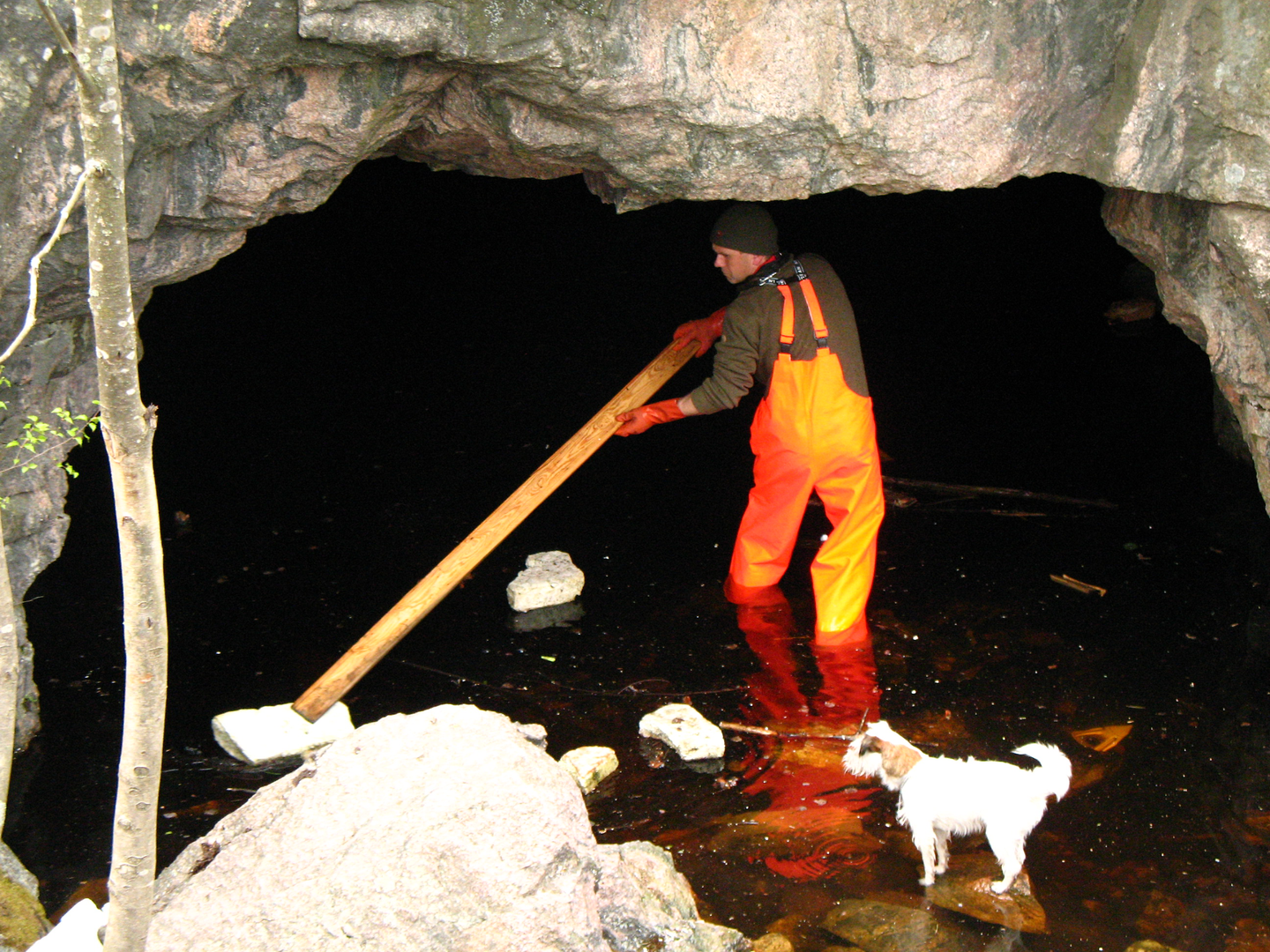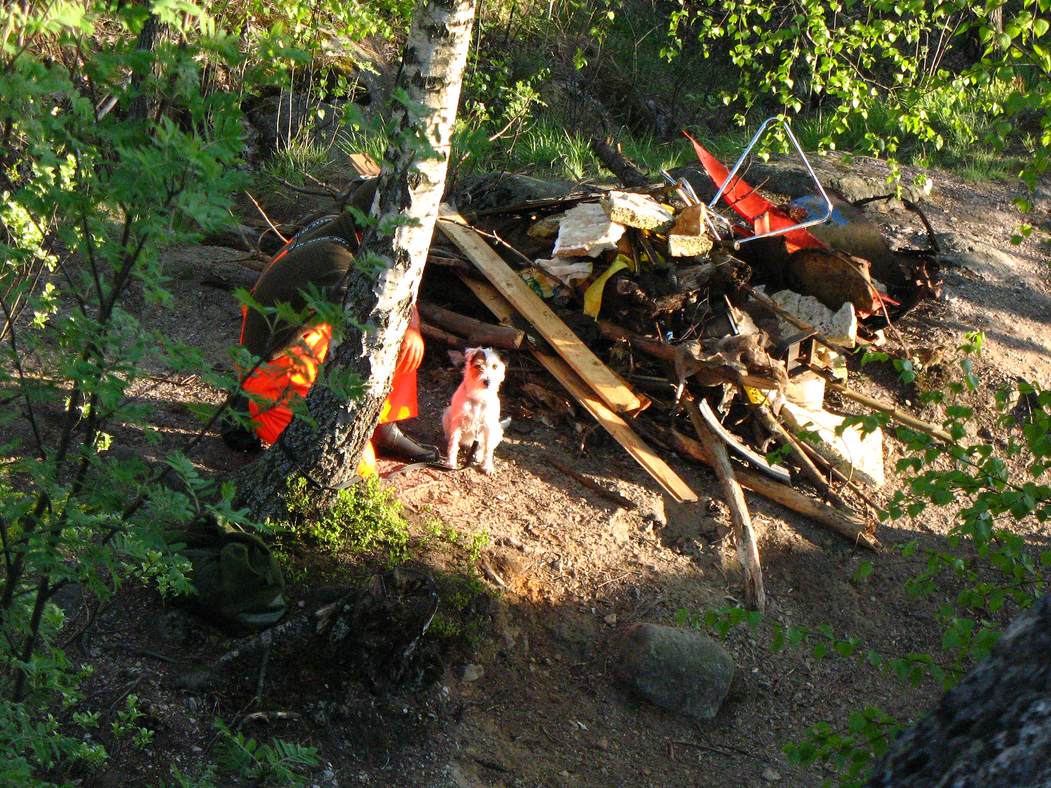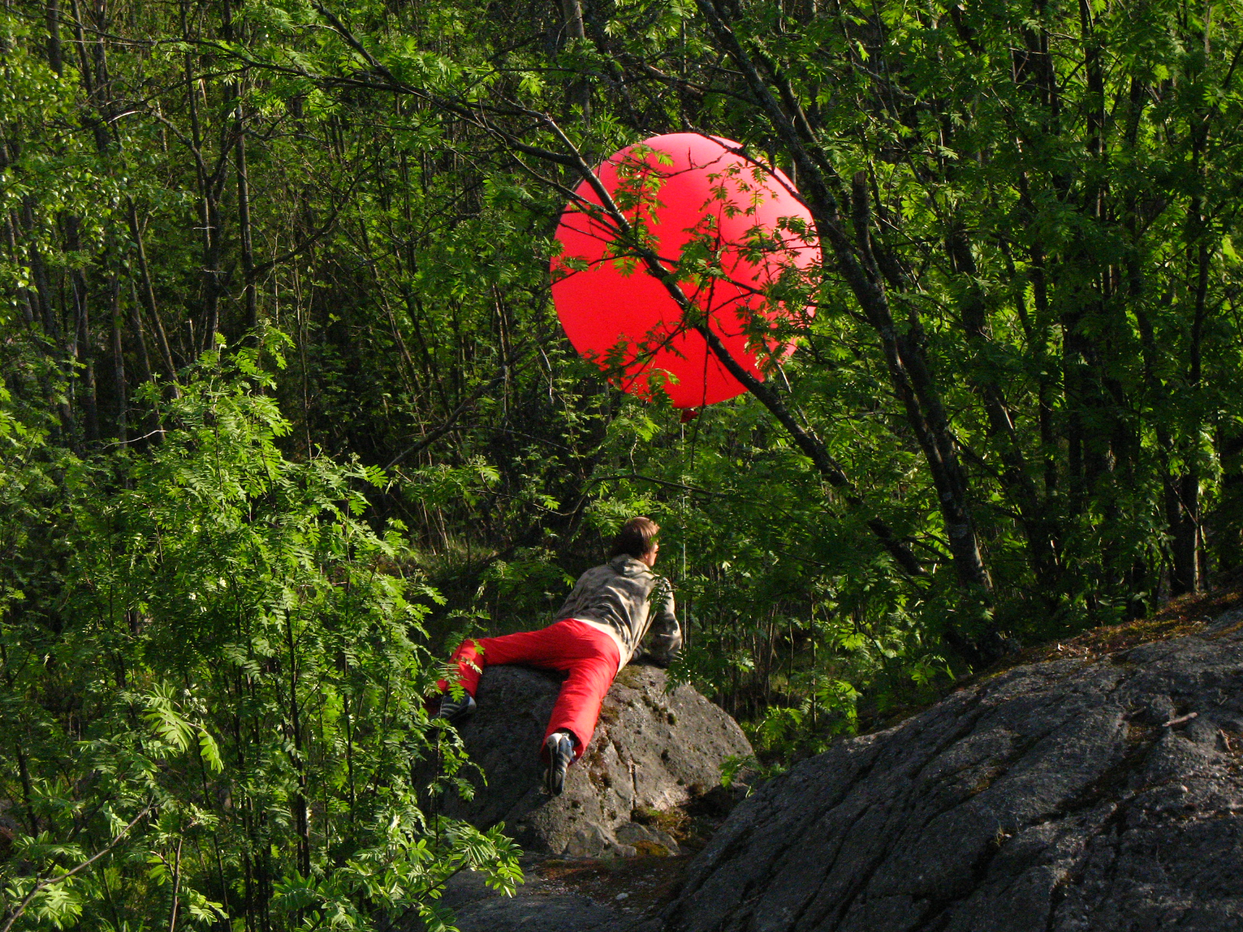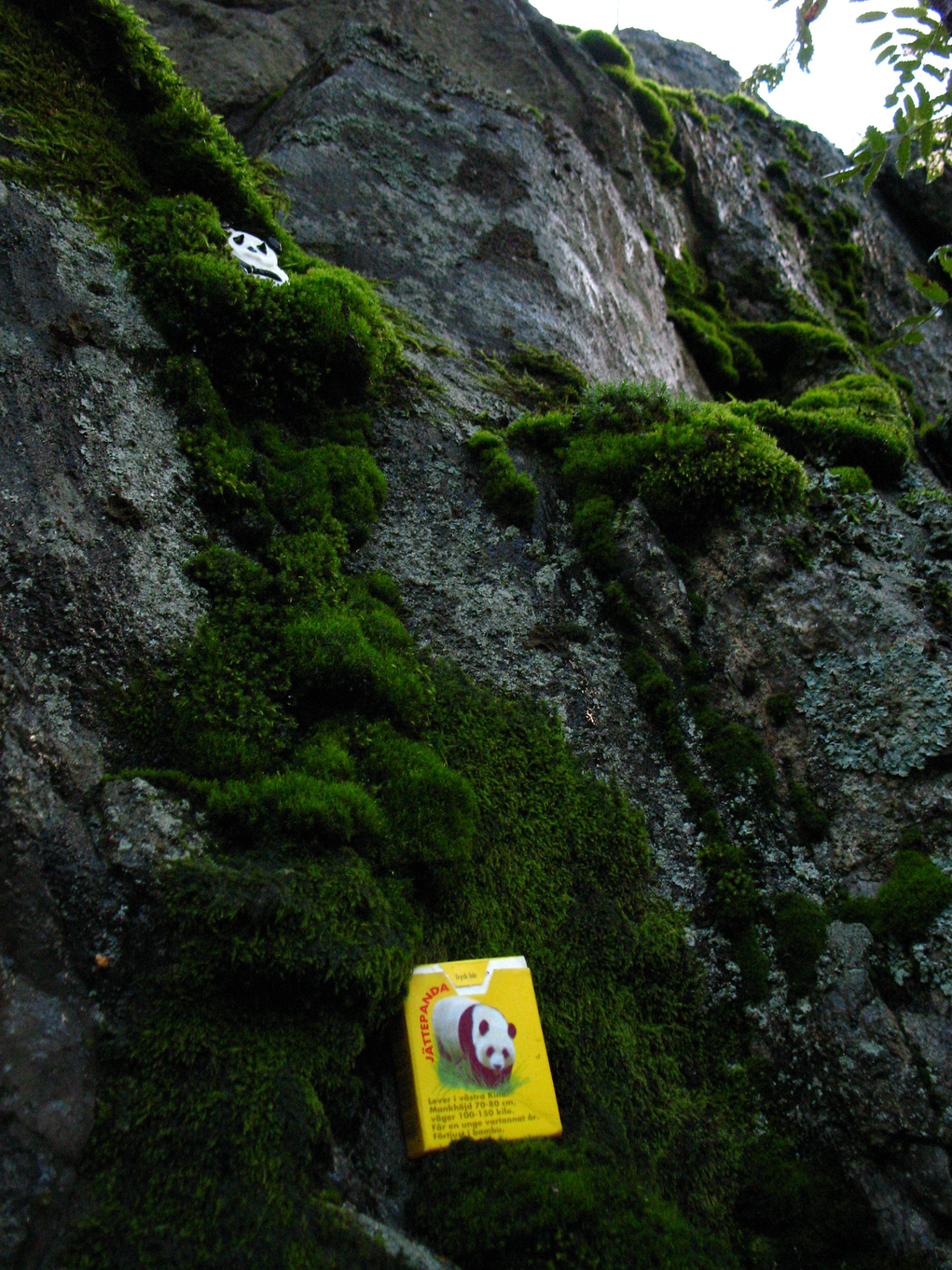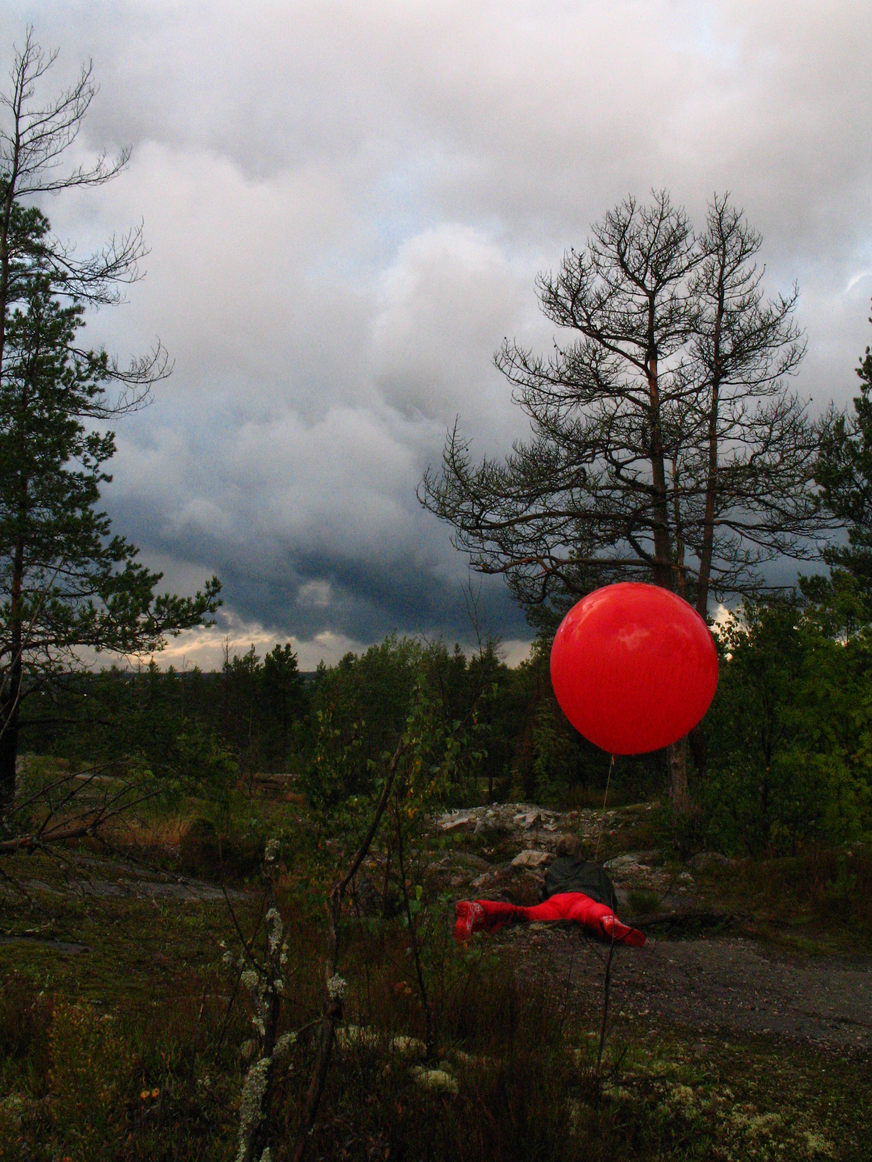I Non-human Co-Actors: Acting with Weather
I begin amid the things, the performance and the rocks, where walks a human called a spectator or a visitor. He crosses a trench, passes an ancient stone shore, a birch tree coming into leaf, and a pile of planks behind which a hippy lost in the 1970s is lighting a campfire. He reaches the edge of the cliff where there is a white table and two chairs. The visitor sits down at the table. The chair wobbles. He looks at the chart of a cloud classification on the table, originating from the international Cloud Committee at the end of the nineteenth century, the sky and the city. About a kilometre away, on the edge of another cliff, there is a similar table with a man sitting there for hours on end, beginning to feel the chill, watching the clouds, the setting sun, the forest, the motorway and aeroplanes taking off from the runway behind the road. A visitor sits down next to him. A woman holding an enormous red balloon on the end of a string, is crawling through the performance from the first cloud committee table to the other, in amongst the trenches, the ants, the wood violets, the snakes and the spectators. Between the two tables, beneath, at the foot of a third cliff, is a cave where a man and a terrier are wading through the water, one catching air bubbles, the other picking up garbage. Elsewhere in the forest, a woman is standing on stairs without a house, looking into a video camera on a tripod with nobody behind it. A helicopter flies overhead; a bird sings. One visitor sits motionless, for a long time, on a concrete slab in the middle of a clearing that looks like a stage, listening to an mp3 player, looking at the woman listening to the helicopter. This is all recorded on the video camera. Two crouching viewers have come across the time capsule for a fading world, spread out on the moss and in the hollows of the rock face. In another place, a spectator is sitting on the cliff, an ant creeps up her leg; the air smells of rain; planes land and take off; a dog growls; the motorway rumbles. Time passes. The clouds form a queue. The sun sets, the sky heaves.
Later, in the autumn, after the storm and the rainbow, I encounter a spectator on a path, with the pockets of her army jacket bulging with mushrooms. Along the next path, a group of Thai women, is crouching down with baskets on their arms. The man performing with the dog comes up after the performance with two boletuses in his hands and says: these were growing on the stage. An sms from two viewer says: we found the ingredients for dinner at the performance. Another message from a viewer: the dog bit me. One of the dogs that roamed the paths in the evenings.
On another evening, on the roof of a department store, we perform everything for a dog. But we also perform for the clouds, as we spend most of the time looking out towards the horizon and the sky, and as they surround us also when human visitors have gone. A few evenings later, the dog chooses her place in a formation of two performers, and starts looking at the clouds.
Five Questions
I will now address five interlinked questions arising from this performance. What do the viewers perceive when they watch (this) outdoor performance? In a performance in which human actors are weak agents or whose agents are not all humans, the question of watching and spectatorship becomes a question of perception. I will link this directly to the question of agency. Which kinds of action and actors do we perceive, and which do we shut out, particularly in this case when the performance is placed outdoors? How and with whom do we act? I also relate to this the question of potentiality: How to perceive and recognise things, which only exist potentially? How to produce this potentiality in a performance? What is the significance of impotentiality - of not-acting and incapacity? Also connected to this is the question of time: How does our ability to perceive the actors and their relations to one another affect our perception of time? What politics of time does our relation to non-human actors and durations require and what can it produce? And all the previous questions relate to the question of the boundary of the performance, its inside and potential outside.
The Invisible Part of Performance
The oldest, most invisible and yet most significant mycelium in the performance is a practice and set of views shaped over a long span of time, ones from which the central, if not always conscious, choices of the specific performance occur. Like my research as a whole, A Performance with an Ocean View is based on three views. The first of these is understanding the performance in terms of relationships: my holistic understanding of performance and the world as a complicated network of different agents dependent both on their environments and on each other, and connected to one another in a variety of ways. The second is a view of the performance and the world - and also of their respective subjectivities - as producing one another. The third view is that surrounding the boundaries and relations between humans, nature and machines is a political, ethical and aesthetic area in which the fundamental questions of our age are condensed.
Time has been the most important tool in my work and one of the central materials I have used in exploring the relationship to (performance) place/environment. In this way, all of my performances (from 1992 onwards) have been site-specific performances that move between different disciplines and genres taking contemporary theatre and performance art as their primary starting point, approaching visual art, specifically conceptual and environmental art, and to a certain extent bio-art, given the subject and material of these performances.
In my artistic research I explore the relations and connections between the human and the non-human as a space where the performance takes place. I approach these relationships from the perspectives of duration and potentiality. With the term 'non-human', I refer primarily to nature, to the ways we understand and have understood the cultural historical ideas of nature. The 'nature' that we know today has been shaped both by the actions of people of the past and by their perceptions of nature. This relationship to 'nature' is plural and complex. In addition to existing alongside other species, humans themselves consist of a variety of different species. We also regularly fill ourselves with non-human elements, such as air and other species that we use for our nourishment; indeed there is no place on earth untouched by the impact of human activity - and no human not directly affected by the feedback of our impact on nature. For these reasons I perceive the human and non-human worlds as inseparably intertwined with each other. 'Nature' is a precondition for existence: "[...] the totality of the processes at the foundation of humans existence forms nature that holds meaning for humans [...] Nature is also 'larger' than the sum of experiences created by human life practices." (Haila & Lähde 2003: 14) Thus the question is of necessity of how we define nature and how we understand ourselves. As cultural anthropologist Raymond Williams, who has researched human concepts of nature, points out: "Our concepts of nature are in fact our concepts of humans projected on to nature." (2003: 62)
The problem of the term 'non-human' is an old and familiar one: it is based on a binary opposition and takes as its starting point the human perspective, as something different from and opposed to "nature". However, I still think that the term can be useful so far, since its dichotomised, out-of-place being does not allow us to forget the split, built into our understanding, from which the most difficult problems arise. My research is not, however, about denying the human, as this formulation of questions is sometimes interpreted. On the contrary, this is essentially an attempt to ask how humans and human subjectivity are linked to the ways in which we understand the non-human; who are we in this world and in the environment in which we live? This research is about what role, and significance, performance can hold for the questions above, and how an examination of these questions can affect performance practices and theory. Furthermore, this research aims to explore what kinds of potential relationships to nature and the non-human are - and could be - opened up in performance.
A Performance with an Ocean View (and a Dog/for a Dog) - II Memo of Time
Mr Nilsson - I Memo of Time examined humans' relation to animals and death. The second memo focused on our relation to the weather and the air. The starting points of making A Performance with an Ocean View... were weather, time, potentiality and non-human agencies. The weather formed the performance space, its subject and material.
In the beginning of my research I considered the weather and air as non-human elements that are constantly changing, becoming more visible and conflicting. On the other hand air is the matter in which we live, that surround us but that we also sense internally. Air fills us and flows through us, but it also connects us - we all breathe the same air. At the same time, due to the growth of humans' potency and of global power, this condition of our lives has become a source of potential catastrophes. During the years working on this project the relationship of performance and of art to the human made changes concerning the whole planet and threatening conditions of life inevitably became the ground of the performance. I approached the weather also as a function between duration and place. These thoughts defined the choice of where to perform. The two performance locations and the relationship between them came to form the core of the performance itself, as well as the first conceptual level, which could function as a textual artwork on its own.
The performances took place outdoors, in two 'in-between places' and 'in-between times': on an ancient shore and on a potential future shore. The first performance (and a Dog) took place on the prehistoric shore of the post Ice Age Yoldia Sea in northern Helsinki, the granite rocks surrounded by the forest at the highest point in the city, situated between the suburbs, the motorway and a small airport. The place was also situated between different times: here amid the marks of today there was a rocky beach formed 10,000 years ago by the retreating glacier, and First World War trenches and maintenance roads built with the prehistoric rocks. The second performance (for a Dog) took place on a potential future shore on the roof of a department store, which is also the top floor of a multi-storey car park, in the centre of Helsinki; between consumerism, transit and the sky, between this moment and the future.
These performances consisted of a variety of different elements and materials. The performance (and a Dog) on the prehistoric shore spread out wide, and included:
- a bus journey from the city centre to the performance place itself.
- the programme, a small book with texts [1] and a map of the area.
- a tent, where you could get what you needed (advice, soup, warm clothes etc.) and spend time.
- place and weather, which formed the basic elements of the performance and created the concrete atmosphere of it, whereby changes in the weather also transformed the place, the humans, the non-humans, the whole performance.
- mp3 files containing the performers' text and the sound of waves. Spectator were given a player of their own, so that they could listen to the files at their own pace, wherever they wanted, with the choice of re-listening or not listening to them at all.
- joint durational events based on the interaction between humans and non-human actors around the performance area. Some of those we built did not include human actors at all (like Time Capsule for a Fading World or Cloud Committee I). Most of the events were produced by non-human actors. Events built by human agents were e.g.
- a man and a dog picking garbage from the water in a cave and posing by the growing pile of garbage after every item.
- a woman listening to the performance place, by a set of ruined steps and a tree coulisse in the forest, as a video camera recorded the event.
- a man sitting by a table on a high rock and watching the view in front of him (Cloud Committee II).
- a woman crawling with a big red balloon about one kilometre across the performance area.
- the producer at the tent, taking care.
- spectators or visitors, the central actors, who created the relations and connections between these elements and materials for themselves and transformed the diverse fields of perception to actual and potential fields of experience.
On the future shore the performance (for a Dog) was open over a specific time, so the visitors could come and go in their own time. With the exception of the air and the weather, so-called 'nature' - as an environment - was now absent. On the roof, as technological or other kind of mediations, there were small installations, traces of events on the ancient shore and their 'nature sites'. There was also something I called the axis of potentiality, pointing to two different kinds of potentialities or virtualities: to the abilities or skills and to the clouds. On opposite sides of the roof there were a table and two chairs, on the table there was the International Cloud Atlas, on the other The Book of Skills from the 1950s, in between the white arrows of the parking place. All the human performers were standing or sitting on the roof with their backs to the roof and looking out towards the horizon and sky - for hours. They changed places using a set of simple rules. A dog and a human pair, a kind of hybrid, were walking and lying around the roof area and spending time or 'doing time'. All performers spent some time playing or doing other things with the dog.
The Challenge of Perceptibility: Place as a set of Relationships between Co-Actors
I return to the five questions I posed in the beginning, through this pair of performances. What exactly happened in those places, who were the actors in the performances and how? From my point of view, tens of thousands of actors and performers were involved. Central tools in this performance were the concepts drawn from my earlier practise: the weak actor and the non-human actor. By weak actor I mean human actors who can actively choose to weaken themselves, not to use power and strength, even not to act. The actor can concentrate for example on directing the spectators' attention somewhere else, and on helping them to perceive the different (built and chosen) fields of perception in the performance. I also consider weak action to be a powerful form of resistance, or rather a form of regravitating. An even more important tool than the weak actor was the concept of non-human (co-)actor. With that term I refer not only to the diverse agencies of concrete natural events, processes and creatures, but also to the agencies of technological devices, processes and practices.
The Memo of Time performances and the research into their action and agency are linked to the work of the cultural sociologist Bruno Latour. In general they relate to his questioning of the boundaries between nature and the social, and specifically to actor-network theory (ANT) developed by Latour and Michel Callon, in which agency is seen as a quality of a network of different actions. This quality arises throughout the performance process, as the basis of the action remains uncertain and plural, and is possible for both human and non-human actors. "An actor is what is made to act by many others." (Latour 2005: 43-47)[2]
In A Performance with an Ocean View... I focused on the agencies of nature. As the concepts of action and agency define - at least, subconsciously - our understanding of humans, performance and place, it is pertinent to reassess them again. If, like in Cartesian terms, action must be 'internalised', we cannot, giving our contemporary knowledge of ethology and evolution ecology, discount the agencies of animals, as they too display language, culture, morality, intelligence and aesthetics. And if we examine all those creatures and processes that affect human beings' actions and establish the foundations for life, we must also accept plants, non-organic materials or natural processes as actors. (Haila & Lähde 2003: 10) What does this mean from a performance point of view? What are the consequences of extending the concept of agency beyond the human?
One of my observations is that non-human actors materialise the performance and its relation to the space (world), making it perceptible. They create the place - as a space full of actors and their relationships; the place as action. The central actors in A Performance with an Ocean View... were the sun, clouds, wind, rain, temperature, photosynthesis, a carbon atom - in addition to the dogs, ants, snakes, the oldest bedrocks in the world, motorways, wood violets, trenches, aeroplanes, seagulls and so on. We considered them as non-human co-performers, with whom we rehearsed from the outset. During the rehearsing time, almost daily each of us created sketches of performances with non-human actors in several potential performance places.
From Spectator to Action Unit
Opening up the performance to non-human agents changes the central position of the viewer and our perception of spectatorship. According to the German theatre researcher Hans-Thies Lehmann, "Common to all open forms of space beyond drama is that the visitor becomes more or less active, more or less voluntarily a co-actor." (2006: 150) Given the working concepts and methods used in A Performance with an Ocean View..., a variety of complex, shifting relationships and connections were formed between the human and non-human actors.
The central job of our group was to draw attention to the non-human actors in the performance space. Our aim was not simply to turn the spectator into a spectator-performer taking part in the event, but by guiding the visitors' attention, using a variety of methods and means, we strove to suggest new links - or perceiving existing links - to the ubiquitous 'nature' and the non-human world (both internal and external). The viewer was always necessarily connected to the weather and the place, the fundamental elements of the performance, and linked for varying lengths of time to the other performance elements and agents s/he chose. The space in which the spectator was able to move and make choices was exceptionally large, but even given this degree of freedom s/he could not refuse to be a part of the entity that regulated her/his being. With these various possible connections, the spectator inevitably became a unit larger than the individual, a unit in which the agency and positions of spectator and performer mixed and interchanged with one another. These local performance cells can be considered, in the words of Latour, as action units in which not only is the whole larger than the sum of its parts (for instance, a blind man, a dog and a stick), but also an agent in its own right, a network of agents. That being said, defining the boundaries of such action networks in outdoor performances (at least in this one) always ends with the globe and its atmosphere.
Producing (the Experience of) Potentiality
Extending action and agency beyond the human sphere is a more fundamental question for the performance than that of human beings' weak action, but the two are essentially linked to one another. Due to the anthropocentric tradition of theatre and performance art [3], non-human agency goes easily unnoticed by humans unless it is given space and attention. This therefore requires a change in human action. I use the term weak action - stemming from my earlier practice - to describe the way the human performers in A Performance with a Ocean View related to non-human agents and nature. In this performance it can be examined in particular from the perspective of impotentiality.
Giorgio Agamben expands Aristotle's concept of potentiality and demonstrates that the humans way of being, our faculties and skills, and the fact that we "can", is fundamentally potential in nature. We have, for example, a faculty of vision. For me, impressive within this reasoning is Agamben's demonstration that we are potential insofar as we have the potentiality not to act. The potentiality for vision (to see light) means that we have the potential not to see, to experience darkness. "Dynamis, potentiality, maintains itself in relation to its own privation.(...) To be potential means: to be one's own lack, to be in relation to one's own incapacity." (1999: 182) For Agamben, the greatness of human potentiality is exactly the potential not to act, the potential for darkness. "To be free is to be capable of one's own impotentiality." (1999: 183)
The most acute question of our time, relating to the climate, can be seen as a question of not-acting, not-doing: how not to increase, not to consume, not to constantly exceed. Actualising potentiality and increasing potency is more familiar to us than practicing the ability not to act but to increase potentiality - the richness of the mental ecology - and to perceive this event. These abilities and this event were among the basic things that I wished to explore in and with this performance, alongside the concepts and the techniques their creation requires, particularly in relation to 'nature'.
In A Performance with an Ocean View the weak actors, in this case human, aimed to produce potentiality by, for instance, not acting upon their various skills. For example, the lighting designer was sitting at a table that was partly covered with light filters, and did nothing but follow the events opening up across the cliffs, the clouds, the forest, the aeroplane landing and taking-off. By acting through our impotentiality, we tried to suggest and open up different options of where (and how) people might focus their attention and form new assemblies, new events. By combining impotential yet perceptible human action with diverse fields of perception (which consisted of material, sensible actors of "nature" and technology as well as the connections between them) for the spectators, I aimed to introduce a space where new possibilities, abilities and associations can be perceived but not yet understood. [4]
This area is potentiality, an early form of becoming aware and of knowledge, just as carotene is an early form of Vitamin A. The area challenges the human sense of perception: how to perceive subtly, free enough from determination of the past, and to allow things you don't fully understand to affect you? The process of producing this area of potentiality occurs (or here occurred) within the body, therefore it is inevitably partly beyond the verbal. But largely it was the process of producing consciously, through a variety of methods developed in the performance practice, a darkness lightening slowly, in places. For the agent, the experience of such developing potentiality and potential knowledge can be compared to our sense of smell, something that in our outdoor performance came to hold great significance for us human actors both directly and through our canine companion: "in the case of some animals as well as human beings, aroma functions as 'a metonymy for knowledge'." (Lippit 2000: 122) It goes without saying that the transformation of such potentiality or smell into fields of experience and knowledge requires time, as it is a matter for which there can be no guarantees and which is always partial.
The Politics of Time
An essential way to answer this challenge was the use of time in the performance. The performance on the ancient shore was, in a sense, a kidnapping of the audience, who then had to 'do time': the relationship of the performance material to the duration of the performance was such that it was impossible to use time effectively, to 'act' the whole time. The audience was kidnapped and taken into a duration, which acted as a possible 'switch' or a shadow region. On the future shore, time, change and vanishing - principally in relation to 'the actors of nature' - became the performance's primary event.
One central question in A Performance with an Ocean View was how to widen the performance's/humans' perspective of time and the ability to experience duration. The rationale of this question lies, both in performance theory and practice, and in our age. Our inability to comprehend the durational effects of our actions has brought about the current global situation in which human action, producing changes, is comparable to a geological force, and according to certain scholars has given rise to a new geological era, the Anthropocene Period. At the same time, "climate change breaks down the notion of the strict hierarchy of different levels of time and represents a change occurring in geographical time, a change that is happening far more rapidly than had previously been thought possible," as the Finnish environmental politics researcher Yrjö Haila has commented (2007: 328).
Lehmann posits that theatre has always been essentially a question of experienced time, of duration, and not necessarily of time that can be objectively measured. In contemporary theatre, time as such has become an object of the aesthetic experience, and durational aesthetics is one of its central points of interest. (2006: 156) And yet the same narrowness as with the 'durations of the world' can be seen in smaller perspective with regard to our understanding of the temporalities of the performance itself. One of my observations on the reasons for this inability lies in the narrow definition of action and agency within the performance. As the Finnish palaeontologist Mikael Fortelius has noted, our ability to experience time is in direct relation to how we perceive our environment and what processes we are able to notice therein.
The central tool of this performance, non-human agency, was also the most important with regard to the perception of time, as it named many agents and processes that have hardly existed within the world of performance. As I have noted earlier, these agents and the interaction between them creates a space. But that place becomes full only once we take into consideration the durations of the various agents and the diversity of connections that exist between different durations. An organism cannot be in a relationship with its environment without also being in a relationship with the various temporalities of that environment.
The temporal foundation of A Performance with an Ocean View... was built on collaboration with non-human agents. The performance intertwined or tried to open itself up to different non-human rhythms and durations, all of which affected the performance's 'internal durations' and the ways in which we experienced its temporal boundaries. In his book 'Postdramatic Theatre' Lehmann states that "at the end of 1950s, one could observe parallel developments in Informal painting, Serial music and dramatic literature", which led to the loss of time frame (2006: 155). The frame was being replaced by open processuality, which has no structural beginning, middle nor end. In A Performance with an Ocean View..., non-human durations and rhythms also made the temporal frame of the performance as a question to be reflected upon. As one viewer commented: "When does the performance start? In the Ice Age, or when I get on the bus, or when I arrive at the tent?" Once the final human viewer had left the roof of the department store, the performance continued with the section performed to the canine viewer. Has the performance on the potential future shore come to an end, or is it ongoing? Did it end as the dog left, or will it continue until the sea level has reached the top of the roof?
By thus intertwining the different rhythms and durations of non-human agents, it is possible to open up the temporal multiplicity to the performance as a whole. At the same time, the material concreteness of non-human agents and performance spaces raises the question of the temporality of perception and visuality. Multiple times were suggested by the two different geographical performance sites in A Performance with an Ocean View as well. Some viewers experienced the approaching future shore echoing around and through the prehistoric shore, and felt able to move in different directions of time, in pasts and potential futures.
Alongside non-human temporalities, the human performers' slow rhythm and long duration could sometimes appear flashing fast, sometimes the opposite was the case. On the other hand, simply perceiving the non-human actors also demands a different use of time, both in rehearsal and performance. The performance practice was based on slowness. We spent several weeks in the performance places over the period of a year, so that at least to some extent we might be able to perceive the connections between the agents and the processes at work in the different locations and to explore our own relationship to them: what is time of a rock, a mushroom, an adder, the clouds, the rain, a dog? What is the nature of the network of these times and how do we act within it? (At first, with choreographer Ari Tenhula, we also rehearsed very slow events in different sites and weather conditions: slow movements in a hail storm on a cliff in Kivikko, in the biting wind on the roof of the Cable Factory or in the cold spring rain on a shore of Baltic Sea, left traces on our understanding of duration.)
This kind of working and the performance itself was an attempt to create a break, a slow area filled with possibilities; an attempt to dwell in time which - and here I agree with Henri Bergson [5] - itself is both multiplicity and slowness. Time is what prevents everything being given to us immediately. Above all it was an attempt to move from the aesthetics of duration to the politics of time.
The Hospitality of Performance and the Politics of Nature
Widening the performance's action and agency beyond the human, I have traced a mode of performer and performance akin to that of the grass and the ants: a way of existing between other creatures, other things, of joining them, of spreading out. This vision questions the place of human beings, both in the performance and in the world, as well as the limits of the performance. My experience from A Performance with an Ocean View... was that by perceiving and using the relationships between human and non-human, we also perceived more non-human elements in the human subject; humans no longer looked so big within our immediate environment and anthropocentrism did not appear as the only option for the performance.
This raises a more detailed question of the faculty of vision: how to perceive our connectedness with actors that surround and penetrate us all the time - like a background, like a fog of potentiality - such as air, the weather, "nature"? How to perceive the darkness of actors? The change in action presupposes change in our perceptions. And the change in perception presupposes a change in our language, new language or new concepts.
I return to the question at the beginning of this chapter: what is the relation between the performance space and the way we understand agency - one of the things that strongly shape performance practices? How does the place affect what kind of actors and connections we can perceive there? If the black box can be seen as "a state of exception, which has become a rule" (Hannah 2008), has it also become a kind of death machine, which eliminates so-called nature and its non-human actors (the vast majority of the world's actors)? What is the relation between the model of perception provided by the black box and the current ecological crisis? If human actors are defined in relation to place, what is a black-box actor like? Outdoor performance spaces force one either to notice or to eliminate non-human actors, which, on the other hand, are becoming "more and more explicit as the threat of losing them increases", as Latour has commented (2007). An essential question is how to open up black boxes, which are controllable, more to a tight and unpredictable network of non-human actors. In doing A Performance with an Ocean View, I was inspired by Jacques Derrida's idea of hospitality, which I see as a kinder, more open and philosophical version of Latour's idea of connection. That the performance is opened up to mushrooms, clouds, rocks, dogs, rain; that they are already within us, but the (black) boxes prevent us from perceiving this.
Above I have examined what can happen in the simultaneity and interaction between human and non-human agents, and the impact this can have both for performance and for the subjectivities assembled within it. One possibility arising from this interaction is an encounter with the politics of nature. According to Yrjö Haila and the environmental philosopher Ville Lähde, the politics of nature is nature's complicity in the possible transformation of human communities: the creatures of nature take part in the shaping of human possibilities and impossibilities, and our concepts of nature affect what we believe is possible and what impossible. (2003: 9-22)
I consider this shift, extending the agency of performance, also to be a political project. But I do not think of it as a revolution or a rupture, but rather as a moving in between, a joining and a widening, both in the actual and potential areas. This requires a heightened ability to deal with dissonance, because, stretching the notion of agency makes the performance more complex: it includes a whole host of new and strange actors, relations, information, possibilities and impossibilities. I believe that this complexity is unavoidable - for why repeatedly yield to simplicity, when there is a danger of losing sight of weak signs, weak phenomena, the impossible that will soon be possible, although it is not what we wanted, and of the possible that we will lose because we did not perceive it.
[1] The booklet included e.g. Primo Levi's short story 'Carbon', about the circulation of a carbon atom during millions of years, and a description by Jared Diamand of the last Tasmanians, who died out after a genocide at the end of 19th century.
[2] Latour notes that it is no coincidence that the word 'actor' comes from theatre: "To use the word 'actor' means that it's never clear who and what is acting when we act since the actor on stage is never alone in acting." [2005: 46].
[3] Theatre and performance art have always been anthropocentric genres in a special way: not only is their subject matter almost without exception human beings, but human bodies and human time are also at the heart of their appearance. 'Nature' has been generally taken as a self-evident, unconscious terrain, for example a resource or an ideal, from which the performance arises.
